
Table of Contents
Introduction
Looking for a flooring option that combines aesthetics with durability? Metallic epoxy flooring might be the answer. This unique flooring solution has been gaining popularity for its stunning appearance and robust properties. In this article, we will explore everything you need to know about metallic epoxy floors, including the installation process, pros and cons, costing, application methods, different types, and frequently asked questions.
What is Metallic Epoxy Flooring?
Metallic epoxy flooring is a decorative concrete coating that uses metallic pigments to create a beautiful, three-dimensional effect on the surface. The metallic pigments are mixed with epoxy resins and then applied to the prepared concrete surface. As the epoxy cures, it creates a seamless, glossy, and reflective floor that resembles a stunning work of art.
The Process of Installing Metallic Epoxy Floors
Installing metallic epoxy floors requires precision and expertise. The process involves several steps, including surface preparation, primer application, metallic epoxy coating, and a topcoat for protection. The intricate techniques used during installation result in a unique and mesmerizing floor.
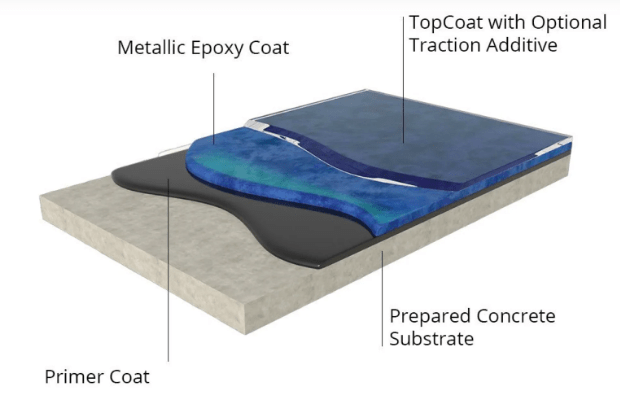
Preparation and Safety Measures
Before you begin the metallic epoxy floor installation, it’s essential to prepare the area properly and take necessary safety precautions. Ensure the following:
- The surface is clean, dry, and free from dust, dirt, grease, or any contaminants.
- Fill any cracks or imperfections in the concrete to achieve a smooth surface.
- Wear appropriate safety gear, including gloves, goggles, and a mask, as epoxy resins can emit strong fumes during the application.
Step 1: Surface Preparation
Proper surface preparation is crucial for the success of your metallic epoxy floor. Follow these steps:
- Clear the area: Remove all furniture, fixtures, and obstacles from the floor.
- Clean the floor: Sweep and vacuum the floor thoroughly to remove any loose debris.
- Degrease the floor: If there are any oil or grease stains, use a suitable degreaser to clean the affected areas.
- Etch the floor (optional): In some cases, especially for smooth concrete surfaces, you may need to etch the floor using an acid-based etching solution. This will help the epoxy adhere better to the surface.
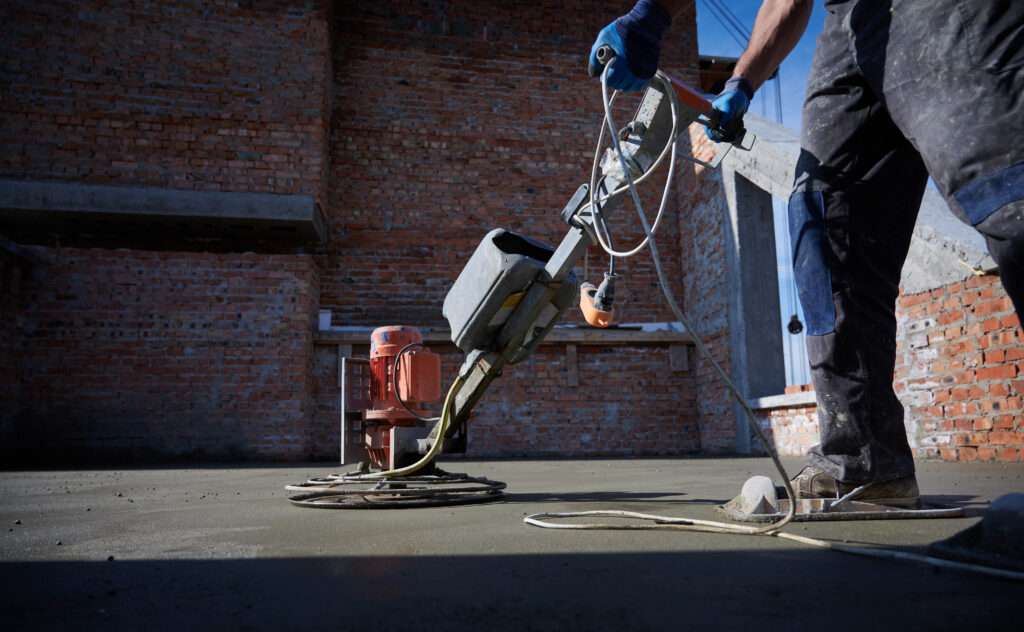
Step 2: Applying Primer
Applying a primer is essential to create a strong bond between the concrete and the metallic epoxy coating. Follow these steps:
- Prepare the primer: Mix the primer according to the manufacturer’s instructions.
- Apply the primer: Use a roller or a brush to apply an even coat of primer to the entire floor surface. Allow it to dry completely before moving to the next step.
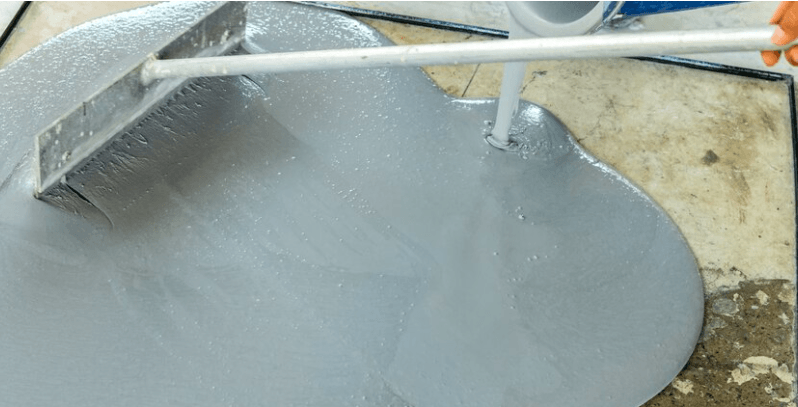
Step 3: Mixing Metallic Epoxy Resin
The next step involves mixing the metallic epoxy resin with metallic pigments. Here’s how to do it:
- Prepare the metallic epoxy: Follow the instructions on the metallic epoxy kit to mix the resin and pigments thoroughly.
- Divide the floor into sections: Divide the floor into manageable sections, as this will help you work efficiently during the application.
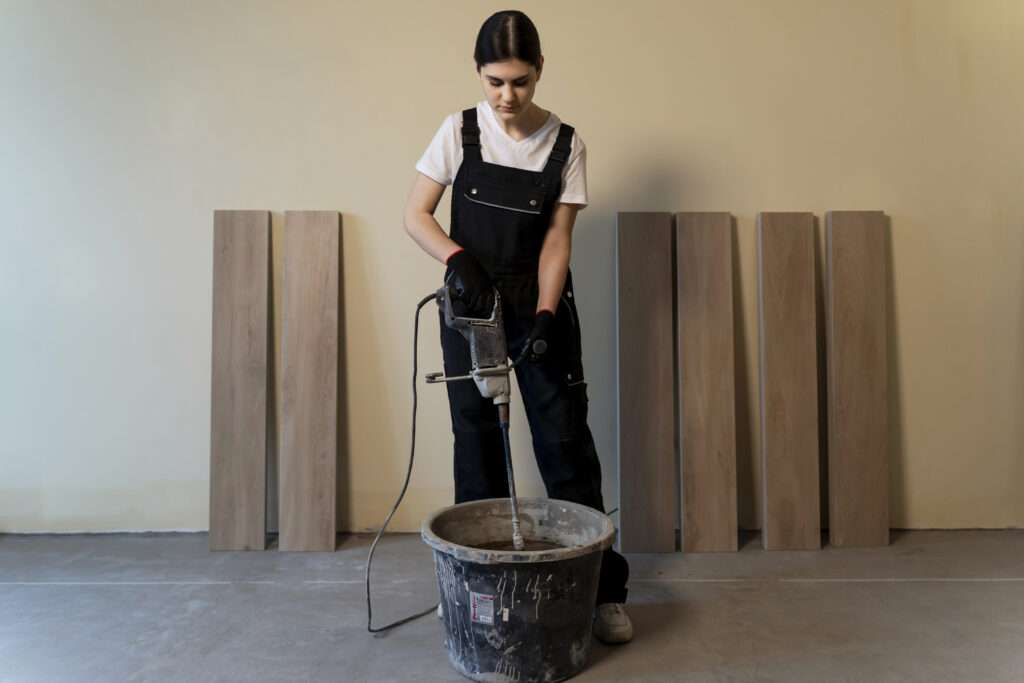
Step 4: Applying the Metallic Epoxy Coating
Now comes the exciting part—applying the metallic epoxy coating. Follow these steps:
- Start applying: Pour the mixed metallic epoxy onto the floor in one of the sections you’ve divided.
- Spread the epoxy: Use a roller or a squeegee to spread the epoxy evenly across the section. Work in a back-and-forth motion to achieve a seamless finish.
- Create movement: To create the unique patterns and designs, manipulate the epoxy with a brush, sponge, or other tools. You can create swirls, waves, or any other desired effects.
- Continue to the next section: Once you’re satisfied with one section, move on to the next and repeat the process.
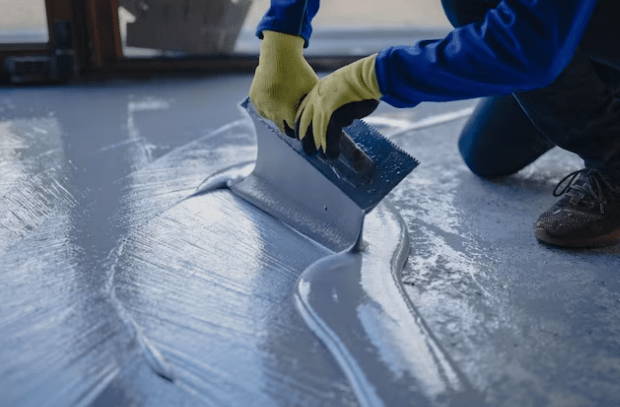
Step 5: Creating Patterns and Designs
Creating patterns and designs is where the artistic aspect of metallic epoxy floors comes into play. Experiment with different techniques and tools to achieve the look you desire.
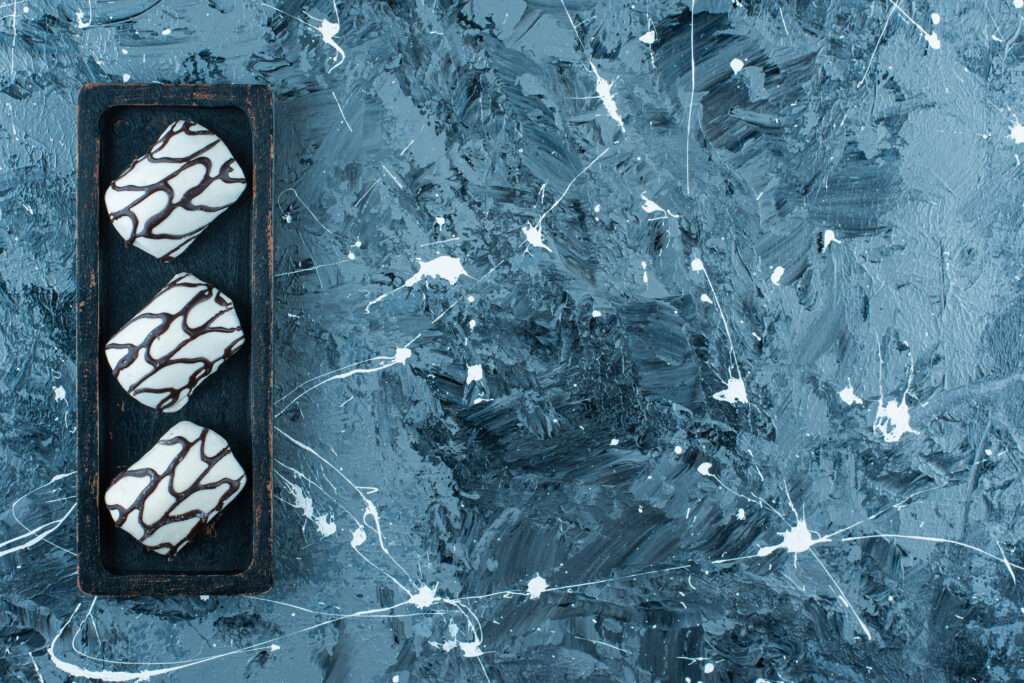
Step 6: Applying a Protective Topcoat
After applying the metallic epoxy coating and creating your desired patterns, it’s time to add a protective topcoat. The topcoat will enhance the durability of the floor and provide a glossy finish.
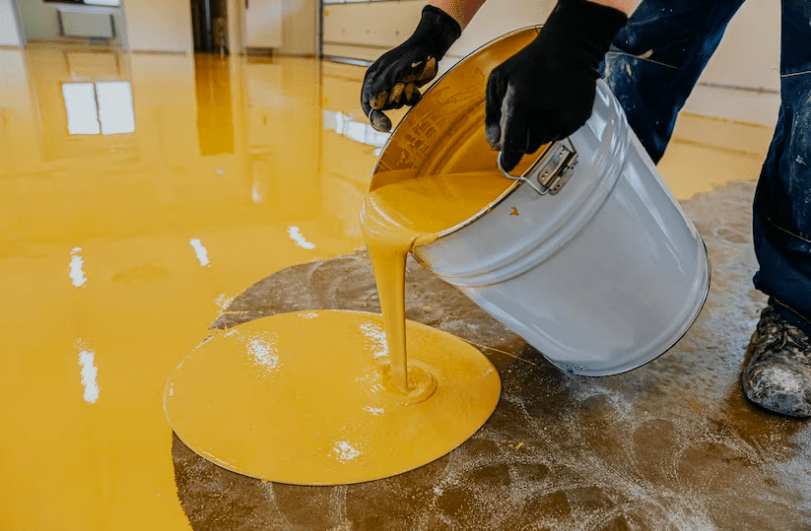
Step 7: Curing and Drying
Allow the metallic epoxy floor to cure and dry according to the manufacturer’s instructions. This may take anywhere from 24 to 72 hours, depending on the product used.
Step 8: Maintenance Tips for Longevity
To ensure the longevity and beauty of your metallic epoxy floor, follow these maintenance tips:
- Clean the floor regularly using a soft mop and mild detergent.
- Avoid using harsh chemicals or abrasive cleaning agents.
- Place felt pads under furniture legs to prevent scratches.
- Use rugs or mats in high-traffic areas to reduce wear.
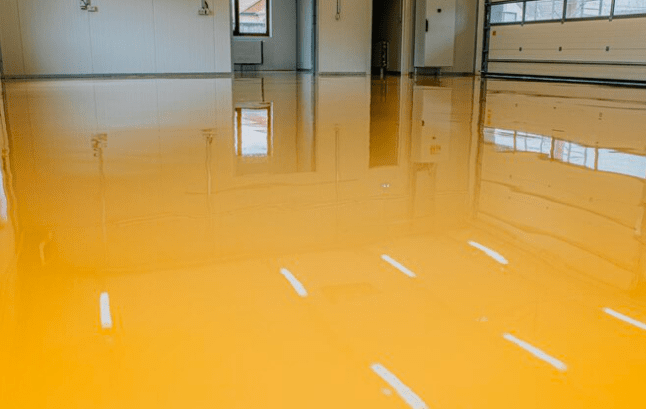
PROS OF METALLIC EPOXY FLOORING
4.1 Unique Aesthetic Appeal
One of the most significant advantages of metallic epoxy flooring is its unparalleled visual appeal. The floor’s glossy and metallic finish with its depth and movement creates a mesmerizing visual effect that stands out in any space.
4.2 High Durability and Longevity
Metallic epoxy floors are incredibly durable and can withstand heavy foot traffic, making them suitable for both residential and commercial spaces. When properly maintained, they can last for many years.
4.3 Seamless and Easy to Clean Surface
The seamless nature of metallic epoxy floors prevents the accumulation of dirt, dust, and bacteria in cracks and crevices, making them easy to clean and maintain.
4.4 Resistance to Chemicals and Stains
Metallic epoxy floors are highly resistant to chemicals, oils, and stains, making them ideal for garages, workshops, and industrial settings.
4.5 Reflective and Light Enhancing Properties
The reflective nature of metallic epoxy floors helps enhance natural light in a room, creating a brighter and more open space.

Cons of Metallic Epoxy Flooring
5.1 Initial Installation Cost
The initial cost of installing metallic epoxy floors can be higher compared to traditional flooring options.
5.2 Professional Installation Required
Due to the complexity of the installation process, hiring a professional contractor is essential to achieve the desired results.
5.3 Susceptible to Scratches and Scuffs
Despite their durability, metallic epoxy floors can still be susceptible to scratches and scuffs, especially in high-traffic areas.
5.4 Time-Consuming Installation Process
Installing metallic epoxy floors can be a time-consuming process, as it involves multiple steps and intricate techniques.
5.5 Slippery When Wet
Metallic epoxy floors can become slippery when wet, posing a potential safety hazard in certain environments.

Costing of Metallic Epoxy Flooring
6.1 Factors Affecting the Cost
Several factors influence the cost of metallic epoxy flooring, including the size of the area, the complexity of the design, and the chosen type of metallic epoxy.
6.2 Average Cost Estimates
On average, metallic epoxy flooring can cost between $8 to $15 per square foot, depending on the factors mentioned above.
6.3 Return on Investment (ROI)
Despite the initial investment, metallic epoxy floors can add significant value to a property, providing a positive return on investment.
Different Ways of Applying Metallic Epoxy Floors
7.1 Thin-Film Metallic Epoxy
Thin-film metallic epoxy involves applying a thin layer of metallic epoxy coating to achieve a subtle, elegant look.
7.2 Self-Leveling Epoxy with Metallic Pigments
Self-leveling epoxy with metallic pigments is poured onto the floor and levels itself, resulting in a seamless, high-gloss finish.
7.3 Metallic Epoxy Flake System
The metallic epoxy flake system incorporates decorative flakes to add texture and depth to the floor’s appearance.
7.4 3D Metallic Epoxy
3D metallic epoxy involves creating stunning visual effects that mimic the illusion of depth and dimension.
7.5 Combination with Other Flooring Types
Metallic epoxy can be combined with other flooring types like concrete, wood, or tiles to create unique and customized designs.
Types of Metallic Epoxy
8.1 Single-Coat Metallic Epoxy
Single-coat metallic epoxy is a simpler application method, ideal for budget-conscious projects.
8.2 Double-Coat Metallic Epoxy
Double-coat metallic epoxy provides added durability and enhanced visual effects due to the additional layer of metallic pigments.
8.3 Solvent-Based Metallic Epoxy
Solvent-based metallic epoxy offers excellent adhesion and durability.
8.4 Water-Based Metallic Epoxy
Water-based metallic epoxy is eco-friendly and emits fewer fumes during installation.
8.5 UV-Cured Metallic Epoxy
UV-cured metallic epoxy cures rapidly under UV light, reducing installation time.
FAQs on Metallic Epoxy Flooring
Is Metallic Epoxy Flooring Suitable For Residential Use?
Yes, metallic epoxy flooring can add a touch of luxury and uniqueness to residential spaces.
Can Metallic Epoxy Floors Be Installed Outdoors?
While metallic epoxy is generally used for indoor applications, some outdoor installations are possible with proper sealing and protection.
How Long Does Metallic Epoxy Flooring Last?
When properly maintained, metallic epoxy floors can last 10-20 years or more.
Can You Apply Metallic Epoxy Over Existing Concrete?
Yes, metallic epoxy can be applied over existing concrete as long as the surface is properly prepared.
Is Metallic Epoxy Flooring Slip Resistant?
Metallic epoxy floors can be made slip-resistant by incorporating additives or textured topcoats.
Can You Customize The Colors And Patterns Of Metallic Epoxy Floors?
Yes, metallic epoxy floors offer endless possibilities for customization, allowing you to create your desired color schemes and patterns.
What Maintenance Does Metallic Epoxy Flooring Require?
Regular sweeping and occasional mopping with mild detergent are usually sufficient to maintain metallic epoxy floors.
Can You Use Metallic Epoxy In High-Traffic Areas?
Yes, metallic epoxy is durable enough to withstand high foot traffic in commercial spaces.
Is Metallic Epoxy Environmentally Friendly?
Water-based metallic epoxy options are considered more environmentally friendly due to their lower volatile organic compound (VOC) emissions.
How Do You Repair Damaged Metallic Epoxy Floors?
Minor scratches or damages can be repaired by reapplying a thin layer of metallic epoxy or using touch-up kits provided by manufacturers.
What is metallic epoxy flooring?
Metallic epoxy flooring is a decorative concrete coating that uses metallic pigments mixed with epoxy resins to create a stunning three-dimensional effect on the floor surface. The result is a glossy, seamless, and reflective finish that adds a touch of elegance and uniqueness to any space.
How does metallic epoxy create the unique three-dimensional effect?
The metallic pigments in the epoxy create a sense of depth and movement when light hits the floor surface. This effect is achieved by the way the metallic particles interact with the epoxy and reflect light, producing a mesmerizing and eye-catching appearance.
Is metallic epoxy flooring durable?
Yes, metallic epoxy flooring is highly durable. When properly installed and maintained, it can withstand heavy foot traffic, making it suitable for both residential and commercial use. Its resilience to stains and chemicals also contributes to its longevity.
Can metallic epoxy floors be used in residential spaces?
Yes, metallic epoxy floors are a popular choice for residential spaces due to their unique aesthetics and durability. They can be installed in various areas of the house, including living rooms, kitchens, bathrooms, and basements.
Are metallic epoxy floors suitable for commercial applications?
Absolutely! Metallic epoxy floors are commonly used in commercial spaces like offices, showrooms, restaurants, and retail stores. Their captivating appearance can help create a memorable and sophisticated atmosphere for customers and clients.
How do metallic epoxy floors compare to other flooring options in terms of cost?
The cost of metallic epoxy flooring can vary depending on factors such as the size of the area, complexity of the design, and chosen type of metallic epoxy. While it may have a higher initial cost compared to some traditional flooring options, its unique aesthetics and durability make it a valuable long-term investment.
Can metallic epoxy be applied over existing concrete floors?
Yes, metallic epoxy can be applied over existing concrete floors, as long as the surface is properly prepared and in good condition. Surface preparation is crucial to ensure a strong bond between the epoxy and the concrete.
Is professional installation necessary for metallic epoxy floors?
While it is possible to attempt DIY installation, professional installation is recommended for the best results, especially for complex patterns and to ensure proper surface preparation and application.
How long does it take to install a metallic epoxy floor?
The installation time for metallic epoxy floors can vary based on the size and complexity of the project. On average, it may take around 2 to 3 days, including the curing time.
Are metallic epoxy floors resistant to stains and chemicals?
Yes, metallic epoxy floors are highly resistant to stains, chemicals, oils, and spills. Their seamless surface prevents liquids from seeping into the floor, making them easy to clean and maintain.
Can metallic epoxy floors be used in high-traffic areas?
Yes, metallic epoxy floors are suitable for high-traffic areas like hallways, entryways, and commercial spaces. Their durability and resistance to wear make them ideal for such environments.
Is metallic epoxy flooring easy to clean and maintain?
Yes, metallic epoxy floors are relatively easy to clean and maintain. Regular sweeping and occasional mopping with mild detergent are usually sufficient to keep them looking their best.
Are metallic epoxy floors safe for pets and children?
Yes, metallic epoxy floors are safe for pets and children. However, it is always a good idea to use rugs or mats in areas where pets or children may be playing to prevent slips and scratches.
Can I customize the colors and patterns of metallic epoxy floors?
Yes, metallic epoxy floors offer a wide range of color options, and you can create custom designs by manipulating the epoxy during the application process.
What are the different application methods for metallic epoxy floors?
Some common application methods for metallic epoxy floors include thin-film coatings, self-leveling epoxy with metallic pigments, metallic epoxy flake systems, and 3D metallic epoxy.
Are metallic epoxy floors suitable for outdoor use?
Metallic epoxy floors are generally used for indoor applications. While some outdoor installations are possible with proper sealing and protection, they may not be as durable as in indoor settings.
How does the curing process work for metallic epoxy flooring?
The curing process involves allowing the epoxy to harden and bond with the concrete. This typically takes between 24 to 72 hours, depending on the product used and environmental conditions.
Are metallic epoxy floors environmentally friendly?
Water-based metallic epoxy options are considered more environmentally friendly as they emit fewer volatile organic compounds (VOCs) during installation.
Can metallic epoxy floors be repaired if damaged?
Minor scratches or damages can be repaired by reapplying a thin layer of metallic epoxy or using touch-up kits provided by manufacturers.
How long can I expect a metallic epoxy floor to last?
With proper maintenance, a metallic epoxy floor can last 10-20 years or more.
Can metallic epoxy floors be installed in areas with moisture or humidity?
Yes, metallic epoxy floors can be installed in areas with moderate moisture or humidity levels. Proper surface preparation and moisture barriers may be necessary to ensure the epoxy’s adherence.
Do metallic epoxy floors provide any additional benefits apart from aesthetics?
Besides aesthetics, metallic epoxy floors can enhance the amount of natural light in a space due to their reflective properties.
Can metallic epoxy floors be used in industrial settings?
Yes, metallic epoxy floors can be used in certain industrial settings due to their resistance to chemicals and stains.
What is the average cost of metallic epoxy flooring installation?
The average cost of metallic epoxy flooring installation can vary depending on factors such as location, area size, and chosen design. On average, it can range from $8 to $15 per square foot.
Can metallic epoxy floors be applied over wooden or tile surfaces?
Metallic epoxy is primarily designed for concrete surfaces, and it may not adhere well to wooden or tile surfaces.
Are metallic epoxy floors resistant to UV rays and fading?
Yes, metallic epoxy floors are generally resistant to UV rays and fading, especially when a UV-resistant topcoat is applied.
Can metallic epoxy floors be used in basements and garages?
Yes, metallic epoxy floors are a popular choice for basements and garages due to their durability and resistance to stains.
What is the recommended thickness of the metallic epoxy coating?
The recommended thickness of the metallic epoxy coating can vary based on the product used, but it is typically applied in thin layers to achieve the desired effect.
Are metallic epoxy floors slippery when wet?
While metallic epoxy floors can have a glossy finish, they can be made slip-resistant by incorporating additives or textured topcoats.
Do metallic epoxy floors require any special maintenance over time?
Regular cleaning and maintenance are generally sufficient to keep metallic epoxy floors looking their best. Avoid using harsh chemicals or abrasive cleaning agents to preserve the floor’s shine.
Conclusion :
Metallic epoxy flooring is a fantastic choice for those looking to transform their space with a striking, durable, and customizable flooring option. While it may come with some drawbacks, the unique aesthetics and impressive properties make it a worthy investment for both residential and commercial applications. So, if you want to add a touch of luxury and elegance to your floors, consider exploring the world of metallic epoxy.
If you are planning this for your Garage , you can visit garageliving for more details.
Readers are also interested in : RTD Plywood





